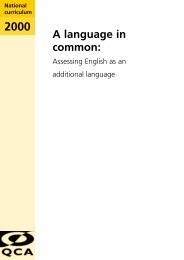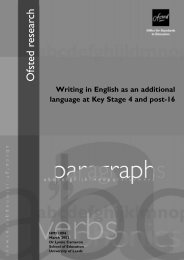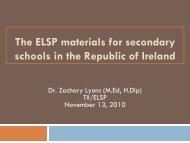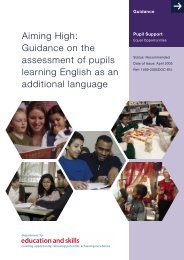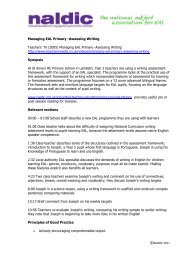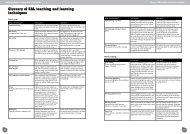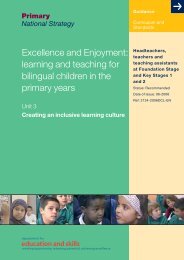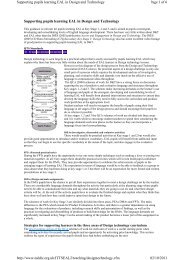Excellence and Enjoyment: learning and teaching for ... - NALDIC
Excellence and Enjoyment: learning and teaching for ... - NALDIC
Excellence and Enjoyment: learning and teaching for ... - NALDIC
Create successful ePaper yourself
Turn your PDF publications into a flip-book with our unique Google optimized e-Paper software.
Identifying priorities <strong>and</strong> planning<strong>for</strong> actionOnce the school has identified how well it is doing in meeting theneeds of bilingual learners through its own school self-evaluationprocess using data analysis tools, <strong>and</strong> having carried out a review ofits current practices, it will be ready to identify key priorities <strong>and</strong> actions<strong>for</strong> improvement. One way of linking key priorities together is throughthe development of a termly Raising Attainment Plan (RAP). The RAP isa key instrument that links together, operationally, the areas of aschool’s focus within four areas:section 3• raising st<strong>and</strong>ards <strong>and</strong> accelerating progress (in this case,<strong>for</strong> bilingual learners);• improving the quality of <strong>teaching</strong> <strong>and</strong> <strong>learning</strong> to meet the needsof bilingual learners;• improving the conditions <strong>for</strong> <strong>learning</strong>;• developing the school as a <strong>learning</strong> community.As a focused short-term operational plan identifying specificimprovements at classroom <strong>and</strong> whole-school levels to supportchildren’s achievements in a discrete area such as this, the RAPeffectively underpins the school improvement plan. In order toachieve this, RAPs include:• specific targets related to children’s <strong>learning</strong>, progress <strong>and</strong>attainment (whole-school <strong>and</strong> specific group level);• a limited number of objectives <strong>and</strong> actions linked to the target.Objectives identify what has to be achieved by the end of theterm. Actions identify the tasks which need to be undertaken(by whom <strong>and</strong> by when) to achieve success;• success criteria which are linked to the targets <strong>and</strong> used toevaluate outcomes/impact of the actions. The success criteriadescribe what the outcomes will look like when they are achieved;• the monitoring arrangements, timescale <strong>and</strong> who is tobe involved. Monitoring focuses on making sure actions agreedare undertaken;• evaluation at the end of term by considering the evidence to checkhow well objectives are being achieved.An example RAP is included on the accompanying CD-ROM, whichalso includes audit tools <strong>and</strong> a self-evaluation grid.Primary National Strategy | 0013-2006DCL-EN | © Crown copyright 2006<strong>Excellence</strong> <strong>and</strong> <strong>Enjoyment</strong>: <strong>learning</strong> <strong>and</strong> <strong>teaching</strong> <strong>for</strong> bilingual children in the primary yearsIntroductory guide 25




